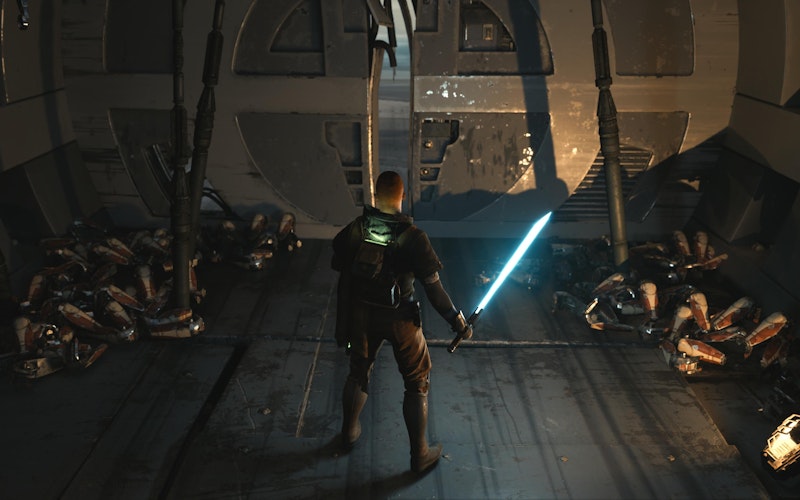
Games
Rising from Relics in Star Wars Jedi: Survivor
Hiding from the Empire on the junkyard planet of Bracca in Star Wars Jedi: Fallen Order, the Jedi Cal Kestis scrambles through a gutted Republic cruiser. On Bracca, starships are not above, but below, the horizon. Countless abandoned cruisers act as mountains, with scuttled Separatist spaceships resting in the vales between. Here, the Clone Wars factions share the same grave. “All share a common destiny,” as the author of Ecclesiastes wrote, one that is repeated and forgotten. Fallen Order’s sequel, Star Wars Jedi: Survivor, visually and narratively expands on this theme.
Before Survivor, other worlds in Fallen Order reveal buried history. Piles of B1 battle droids lie broken in the mud on Kashyyyk; Clone trooper helmets decorate ceremonial stone shrines on Zeffo; Fortress Inquisitorious, a prison for Jedi and training grounds for Jedi hunters, isn’t just a fortress. “It's a tomb,” as Obi-Wan Kenobi remarks in his eponymous streaming series. The fact that this tomb was built beneath a moon’s dark ocean drives the point home.
In Survivor we see remnants of the High Republic era. This period has primarily been told through books and comics since 2021, creating all new characters and conflicts long before the Clone Wars. The High Republic was a “golden age,” a time when sincere Jedi and politicians—amidst architecture that was white and gilded, smooth and rounded, classy and regal—sought to share their prosperity with the galaxy. In Survivor, these buildings are falling apart and overtaken by nature. Their technological marvels hang in the sky, operational yet abandoned and neglected. As you roam the High Republic halls, Stormtroopers and repurposed battle droids fight each other and you; multiple eras collapse in on each other and clash, vestiges of battles won and lost.
Survivor also highlights the ancient history of religious orders on Jedha, the desert moon first seen in Rogue One, with its crumbling statues and Petra-like buildings. In Survivor, you walk through these structures and crypts while helping a secretive sect preserve and study Jedi teachings. Playing as Cal, you feel like an archeologist, collecting artifacts and hearing history through a Force ability called psychometry.
Multiple eras collapse in on each other and clash, vestiges of battles won and lost.
Ruins are core to the appeal and storytelling of Star Wars. “Lucas taps into the same power the mention of anything ‘ancient’ seems to have over audiences,” says archeologist Dr. David Anderson. “He richly embellishes his universe with pyramids, standing stones, ancient religions . . . and a longing for a lost golden age.” Anderson adds that ruins “endure into the present with a promise that we can be better, that things were better.” The rise and fall of myriad societal and cultural monoliths remind us that this is the humbling “natural order of things.”
Just as Survivor prompts players to reflect on ruins, the Bible is a miraculously surviving account of humanity’s cycle of failure. From the time of the Judges to the tumultuous line of royalty in Chronicles and Kings to the Babylonian exile, God’s people go back and forth between prosperity and despair. If this is the pattern of existence, what hope is there in continuing to do good? Cal wonders if progress is attainable when his struggle against the Empire is cast against the backdrop of ruin and failure.
If you listen to members of the religious sect on Jedha, they’ll wax philosophical about cycles. One devotee says, “We suffer the cycle of the Force of others.” Another says there’s “inevitability” yet “enlightenment” in accepting one’s role within it. Survivor’s antagonists wish to either escape the cycle or destroy it, echoing the apathy of Luke and the violence of Kylo Ren in The Last Jedi. (The sequel trilogy as a whole shows a generation both in awe of and haunted by the past.) Whereas Kylo further cements his path in the cycle by attempting to break it, Luke’s acceptance of it grants him peace and perspective. He realizes that the Jedi’s failures —including his own—must be acknowledged if the Jedi are to evolve and achieve a greater and lasting freedom from the cycle.
It’s hard to say if darkness will ever be defeated in the Star Wars universe, but in Star Wars Jedi: Survivor, Cal chooses to hope against hope. He may not know the outcome of his efforts, but wherever history leads, he says, “It's hard to stop suffering in the galaxy, but it's always worth the effort." In the Christian worldview, even when evil seems to continually return and overwhelm good, history draws ever closer to God’s kingdom. In Upside-Down Apocalypse, Jeremy Duncan writes that the book of Revelation is “a profound statement about the goodness of God and the unfolding of time, and a reminder that nothing is left to chance” because “the Spirit is active and present, pulling history back toward the Creator.”
Indeed, since we know that “death has been swallowed up in victory” by Christ, we can rest in the assurance that all our “labor in the Lord is not in vain.”
Topics: Games